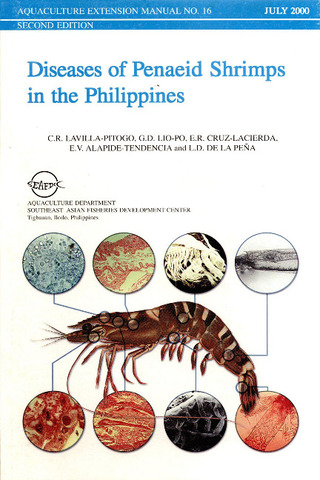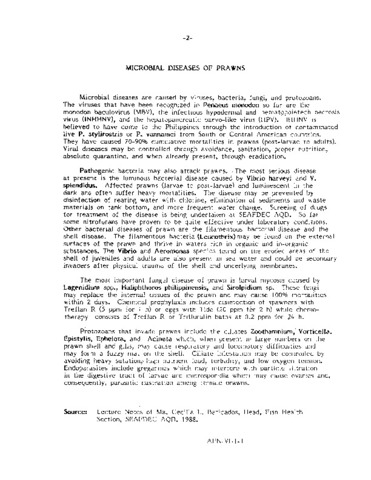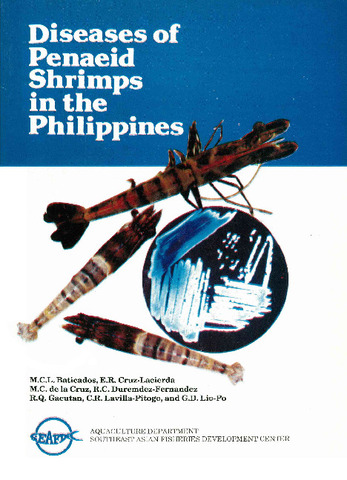Studies on the experimental transmission model of monodon baculovirus (MBV) and hepatopancreatic parvovirus (HPV) in shrimp (Penaeus monodon)
| dc.contributor.author | Catap, Elena S. | |
| dc.contributor.author | de la Peña, Leobert D. | |
| dc.contributor.editor | Nagasawa, Kazuya | |
| dc.date.accessioned | 2020-07-21T00:59:44Z | |
| dc.date.available | 2020-07-21T00:59:44Z | |
| dc.date.issued | 2005-03 | |
| dc.identifier.citation | Catap, E. S., & de la Peña, L. D. (2005). Studies on the experimental transmission model of monodon baculovirus (MBV) and hepatopancreatic parvovirus (HPV) in shrimp (Penaeus monodon). In K. Nagasawa (Ed.), Recent Advances in Diagnosis and Prevention of Fish and Shrimp Diseases in Southeast Asia (pp. 29–37). Tigbauan, Iloilo, Philippines: Aquaculture Department, Southeast Asian Fisheries Development Center. | en |
| dc.identifier.isbn | 9718511732 | |
| dc.identifier.uri | http://hdl.handle.net/10862/5909 | |
| dc.description.abstract | Series of experiments on the transmission of monodon baculovirus (MBV) and hepatopancreatic parvovirus (HPV) in Penaeus monodon were undertaken. Feeding of MBV-infected carcasses to experimental shrimps resulted to 100% infection at day 4 post-infection as determined by wet-mount technique and histopathology of hepatopancreas. Oral route of infection was also efficient in inducing HPV infection in postlarval P. monodon. Percentage of infection was 100% at 5-7 days post-infection which was also determined using the wet-mount technique, originally developed for MBV, and through histopathology. Further studies on the transmission of HPV showed that age of shrimps is an important factor in its pathogenicity. Results showed that HPV could be transmitted efficiently in postlarval P. monodon, but less efficient in juveniles. No infection was induced among the adult shrimp samples. It was also shown that the oral route of infection is more efficient in transmitting HPV rather than water-borne inclusion bodies. This is the first report of horizontal transmission of HPV in postlarval P. monodon in the Philippines. | en |
| dc.language.iso | en | en |
| dc.publisher | Aquaculture Department, Southeast Asian Fisheries Development Center | en |
| dc.subject | Baculovirus | en |
| dc.subject | Penaeus monodon | en |
| dc.subject | pathogenicity | en |
| dc.subject | hybridomas | en |
| dc.subject | Artemia nauplii | en |
| dc.title | Studies on the experimental transmission model of monodon baculovirus (MBV) and hepatopancreatic parvovirus (HPV) in shrimp (Penaeus monodon) | en |
| dc.type | Book chapter | en |
| dc.citation.spage | 29 | en |
| dc.citation.epage | 37 | en |
| dc.citation.bookTitle | Recent Advances in Diagnosis and Prevention of Fish and Shrimp Diseases in Southeast Asia | en |
| dc.subject.asfa | histopathology | en |
| dc.subject.asfa | animal diseases | en |
| dc.subject.asfa | viral diseases | en |
| dc.subject.asfa | pathogens | en |
| dc.subject.asfa | disinfection | en |
| dc.subject.asfa | disease transmission | en |
| dc.subject.scientificName | Penaeus monodon | en |
Files in this item
This item appears in the following Collection(s)
-
Recent Advances in Diagnosis and Prevention of Fish and Shrimp Diseases in Southeast Asia [43]
Terminal Report of the Regional Fish Disease Project on “Development of Fish Disease Inspection Methodologies for Artificially-Bred Seeds” Funded by the Government of Japan Trust Fund from 2000 to 2004


 AQD Access only
AQD Access only



